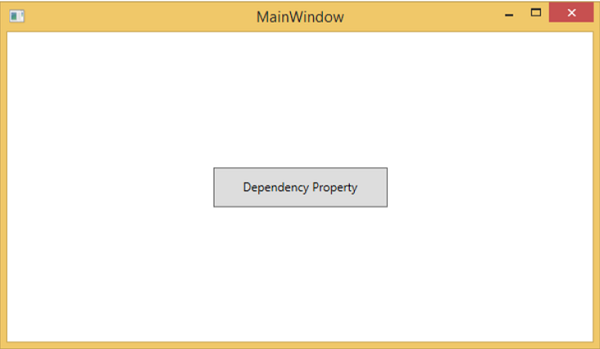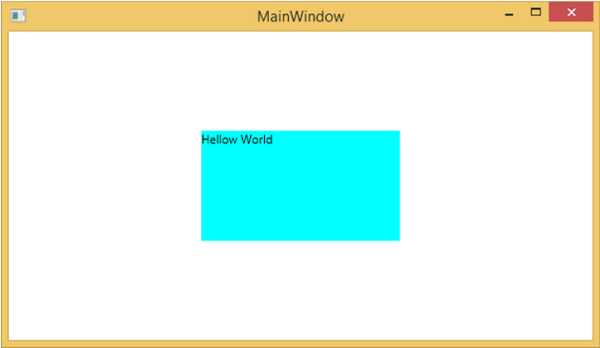
- WPF - Home
- WPF - Overview
- WPF - Environment Setup
- WPF - Hello World
- WPF - XAML Overview
- WPF - Elements Tree
- WPF - Dependency Properties
- WPF - Routed Events
- WPF - Controls
- WPF - Layouts
- WPF - Nesting Of Layout
- WPF - Input
- WPF - Command Line
- WPF - Data Binding
- WPF - Resources
- WPF - Templates
- WPF - Styles
- WPF - Triggers
- WPF - Debugging
- WPF - Custom Controls
- WPF - Exception Handling
- WPF - Localization
- WPF - Interaction
- WPF - 2D Graphics
- WPF - 3D Graphics
- WPF - Multimedia
WPF - Dependency Properties
In WPF applications, dependency property is a specific type of property which extends the CLR property. It takes the advantage of specific functionalities available in the WPF property system.
A class which defines a dependency property must be inherited from the DependencyObject class. Many of the UI controls class which are used in XAML are derived from the DependencyObject class and they support dependency properties, e.g. Button class supports the IsMouseOver dependency property.
The following XAML code creates a button with some properties.
<Window x:Class = "WPFDependencyProperty.MainWindow"
xmlns = "http://schemas.microsoft.com/winfx/2006/xaml/presentation"
xmlns:x = "http://schemas.microsoft.com/winfx/2006/xaml"
xmlns:local = "clr-namespace:WPFDependencyProperty"
Title = "MainWindow" Height = "350" Width = "604">
<Grid>
<Button Height = "40" Width = "175" Margin = "10" Content = "Dependency Property">
<Button.Style>
<Style TargetType = "{x:Type Button}">
<Style.Triggers>
<Trigger Property = "IsMouseOver" Value = "True">
<Setter Property = "Foreground" Value = "Red" />
</Trigger>
</Style.Triggers>
</Style>
</Button.Style>
</Button>
</Grid>
</Window>
The x:Type markup extension in XAML has a similar functionality like typeof() in C#. It is used when attributes are specified which take the type of the object such as <Style TargetType = "{x:Type Button}">
When the above code is compiled and executed, you would get the following MainWindow. When the mouse is over the button, it will change the foreground color of a button. When the mouse leaves the button, it changes back to its original color.

Why We Need Dependency Properties
Dependency property gives you all kinds of benefits when you use it in your application. Dependency Property can used over a CLR property in the following scenarios −
- If you want to set the style
- If you want data binding
- If you want to set with a resource (a static or a dynamic resource)
- If you want to support animation
Basically, Dependency Properties offer a lot of functionalities that you wont get by using a CLR property.
The main difference between dependency properties and other CLR properties are listed below −
CLR properties can directly read/write from the private member of a class by using getter and setter. In contrast, dependency properties are not stored in local object.
Dependency properties are stored in a dictionary of key/value pairs which is provided by the DependencyObject class. It also saves a lot of memory because it stores the property when changed. It can be bound in XAML as well.
Custom Dependency Properties
In .NET framework, custom dependency properties can also be defined. Follow the steps given below to define custom dependency property in C#.
Declare and register your dependency property with system call register.
Provide the setter and getter for the property.
Define a static handler which will handle any changes that occur globally
Define an instance handler which will handle any changes that occur to that particular instance.
The following C# code defines a dependency property to set the SetText property of the user control.
using System;
using System.Collections.Generic;
using System.Linq;
using System.Text;
using System.Threading.Tasks;
using System.Windows;
using System.Windows.Controls;
using System.Windows.Data;
using System.Windows.Documents;
using System.Windows.Input;
using System.Windows.Media;
using System.Windows.Media.Imaging;
using System.Windows.Navigation;
using System.Windows.Shapes;
namespace WpfApplication3 {
/// <summary>
/// Interaction logic for UserControl1.xaml
/// </summary>
public partial class UserControl1 : UserControl {
public UserControl1() {
InitializeComponent();
}
public static readonly DependencyProperty SetTextProperty =
DependencyProperty.Register("SetText", typeof(string), typeof(UserControl1), new
PropertyMetadata("", new PropertyChangedCallback(OnSetTextChanged)));
public string SetText {
get { return (string)GetValue(SetTextProperty); }
set { SetValue(SetTextProperty, value); }
}
private static void OnSetTextChanged(DependencyObject d,
DependencyPropertyChangedEventArgs e) {
UserControl1 UserControl1Control = d as UserControl1;
UserControl1Control.OnSetTextChanged(e);
}
private void OnSetTextChanged(DependencyPropertyChangedEventArgs e) {
tbTest.Text = e.NewValue.ToString();
}
}
}
Here is the XAML file in which the TextBlock is defined as a user control and the Text property will be assigned to it by the SetText dependency property.
The following XAML code creates a user control and initializes its SetText dependency property.
<Window x:Class = "WpfApplication3.MainWindow"
xmlns = "http://schemas.microsoft.com/winfx/2006/xaml/presentation"
xmlns:x = "http://schemas.microsoft.com/winfx/2006/xaml"
xmlns:views = "clr-namespace:WpfApplication3"
Title = "MainWindow" Height = "350" Width = "604">
<Grid>
<views:UserControl1 SetText = "Hellow World"/>
</Grid>
</Window>
Let's run this application. You can immediately observe that in our MainWindow, the dependency property for user control has been successfully used as a Text.
